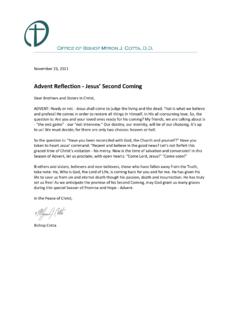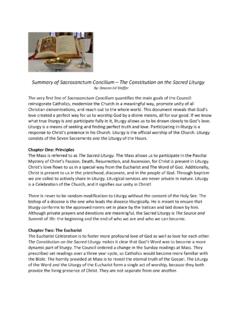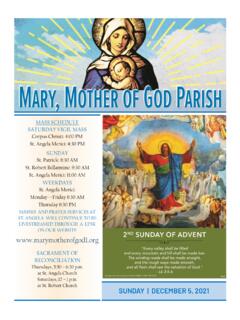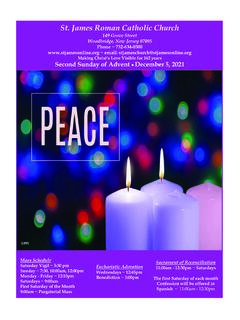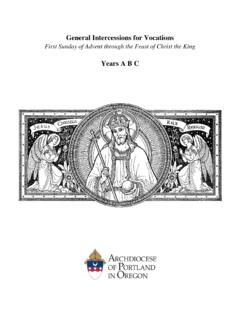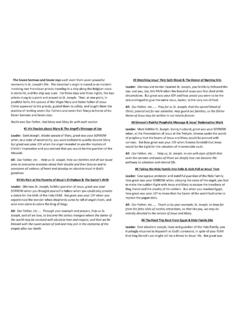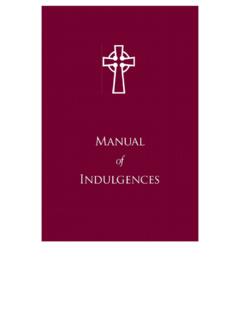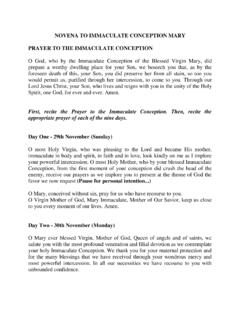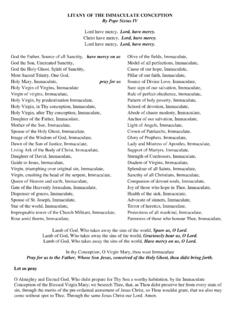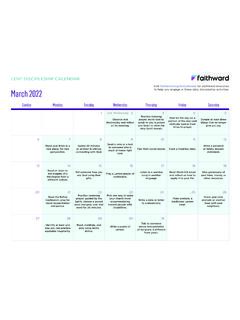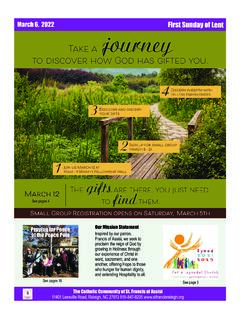Transcription of Lectio Divina for Children and Teens
1 Name: _____ Date: _____ Scripture: _____. Lectio Divina for Children and Teens : Activities to Help Young People Encounter God's Word By Jared Dees The Religion Teacher 2013 All Rights Reserved. Name: _____ Date: _____ Scripture: _____. Introduction How well do we teach our Children to read the Bible? More importantly, how well do we teach our Children to pray with the Bible? The process of sacred reading ( Lectio Divina ). of the Bible is an incredibly important and often overlooked skill to impart in our young people. It is also something we as religious educators should practice frequently ourselves. Lectio Divina is an ancient Catholic practice of reading Sacred Scripture with the help of the Holy Spirit. It is a way of praying with the Bible. Through the method of Lectio Divina , we move beyond just the words on a page to an encounter with an actual person, the living God.
2 The purpose of Lectio Divina is come into contact with our personal God and let ourselves be transformed by his love. The Church considers Lectio Divina to be an important form of continuing catechesis. According to the General Directory for Catechesis: The Church desires that in the ministry of the word, Sacred Scripture should have a pre-eminent position. In concrete terms, catechesis should be an authentic introduction to Lectio Divina , that is, to a reading of the Sacred Scriptures done in accordance to the Spirit who dwells in the Church'.. (GDC, 71). The goal of this collection of handouts is to help young people experience an authentic introduction to Lectio Divina under your guidance. It includes various activities and avenues to encounter the living God in his sacred word. Each handout focuses on various stages of the Lectio Divina experience and helps young people read, understand, and connect the word of God to their own lives.
3 Using these handouts with repeated practice throughout the school year will help your students become better readers of the Bible, but more importantly, better able to meet God in his sacred word. The Basic Steps of Lectio Divina According to Pope Benedict XVI in the post-synodal Apostolic Exhortation, Verbum Domini (nos. 86-87), Lectio Divina is broken down into the following steps named in Latin: Lectio (reading), Meditatio (meditation), Oratio (prayer), and Contemplatio (contemplation). Then, as a result of the encounter with God in Scripture, we are also called to Actio (action). Each of these steps together form a process by which we encounter God and respond to his grace. They form parts of a larger whole, but each one comes with a certain set of skills for our young people to master. Let's look briefly at each step.
4 Name: _____ Date: _____ Scripture: _____. Lectio (Reading). In the first phase of Lectio Divina we understand what the passage we are reading says in itself. This is the literal meaning of the Scripture passage and the lessons everyone should recognize in reading it. At this stage we do not yet consider our own lives in connection with the Scriptures. We do not let our preconceived notions or opinions influence our reading, but seek to understand the message of the passage as interpreted by the Church independently of anyone's opinions. This phase is summarized with the question: What does the text say that everyone should understand? Meditatio (Meditation). In the meditation phase of Lectio Divina , we ask, what does this text say to me, today, and to my life? We allow God to pull up certain memories of people, places, and events in our lives that relate to the passage we are reading.
5 Meditation is also an opportunity to see ourselves in the text. We can consider our own feelings as if we were a participant in the text or try to understand what it would be like to be one of the people represented in the text. In this way we come to a deeper appreciation of how God is working in our lives through the sacred word. Having entered into the story ourselves, we can return to the present and consider the areas in our own lives that God is calling us to contemplate. Oratio (Prayer). Through a meditation on Scripture, we experience an intimate encounter with God that leads us to respond in prayer. Having met our Lord in his holy word, we courageously speak to him in our own words. In this way we consider prayer to be a simple conversation with God. It is a conversation that comes in various forms: we ask petitions of him, we give him thanks, and we give him praise.
6 We might also ask for the intercession of Mary or the saints represented in the passage we read. At this phase we can ask ourselves: What can I say to the Lord in response to his word? Contemplatio (Contemplation). A true encounter with the Lord always leads to transformation. Indeed, the Lord God proclaimed, Behold, I make all things new (Revelation 21:5). Through contemplation we come to an understanding of the parts of our lives that need to be transformed by God's grace. We humble ourselves and open our lives up to his transformative power. This step comes with the willingness to change, an openness and trust in God, and the decision to follow God's will rather than our own. With this decision comes a fear of losing what we find comfortable and safe. At the same time we feel the excitement of a call to heroic adventure and a hopeful future of living the life we are meant to live.
7 We ask ourselves: What conversion of the mind, heart, and life is the Lord asking of me? Name: _____ Date: _____ Scripture: _____. Actio (Action). Although this phase is often not considered to be a part of Lectio Divina proper, it is an essential result of the encounter with God in Sacred Scripture. As Pope Benedict XVI. wrote in Verbum Domini, We do well also to remember that the process of Lectio Divina is not concluded until it arrives at action (actio), which moves the believer to make his or her life a gift for others in charity (no. 87). Having received God's love and grace, we go forth to serve others out of the love we have been given. Our transformation calls us to witness to others; it calls us to selflessly serve our brothers and sisters in Christ. These acts are done not so much out of a sense of duty, but out of the inspiration we receive from the acceptance in faith of God's love.
8 How to Use the Handouts The handouts in this package of resources are meant to build up the skills needed to enter deeply into God's word and encounter Christ through the process of Lectio Divina . They contain exercises to allow young people to enter deeply into an encounter with God's word using familiar analogies and activities, but also encourage a more general approach to encountering God in Scripture. Each step of the Lectio Divina process has multiple handouts for you to assign to the students or for them to select on their own. When you first introduce each activity, practice the exercise as a group and model how each handout should be completed. Once you feel students have an understanding of how to use each handout, allow them to choose the exercises they like the best or assign handouts according to what you believe will meet each student's greatest need.
9 These activities are ideal in classrooms that are set up with learning centers. You can select Scripture passages for the students or provide a selection for them to choose from. It would be best early on to focus on certain Scripture passages that you have taught in class and that students will be familiar enough with to enter into using meditation practices . For example, you might have the whole class focus on the same set of parables in the course of a few weeks. You will need to be sure that students understand the meaning of the parables ( Lectio ) before they can enter into a meditation on them (meditatio). If you decide to use these handouts often as bell work or in daily learning centers, provide students with a printout of the daily reading for the Catholic lectionary or make sure students have access to the Internet.
10 The daily readings are available at the United States Conference of Catholic Bishops website: When (or if) you collect these handouts, take note of the kinds of responses you get. How can you help the students engage with each activity in the proper way? As a rule of Name: _____ Date: _____ Scripture: _____. thumb, each student should be able to define a personal connection with some aspect of the reading. If they accomplish nothing else, make sure that this at least is clearly displayed in their work. The handouts and activities that follow are meant to help young people experience each step of Lectio Divina on their own. They are meant to provide the scaffolding needed to approach Scripture in certain ways. Over time, the handouts and activities should be removed just as scaffolding is removed from the side of a building after it has been built or renovated and can stand on its own.
